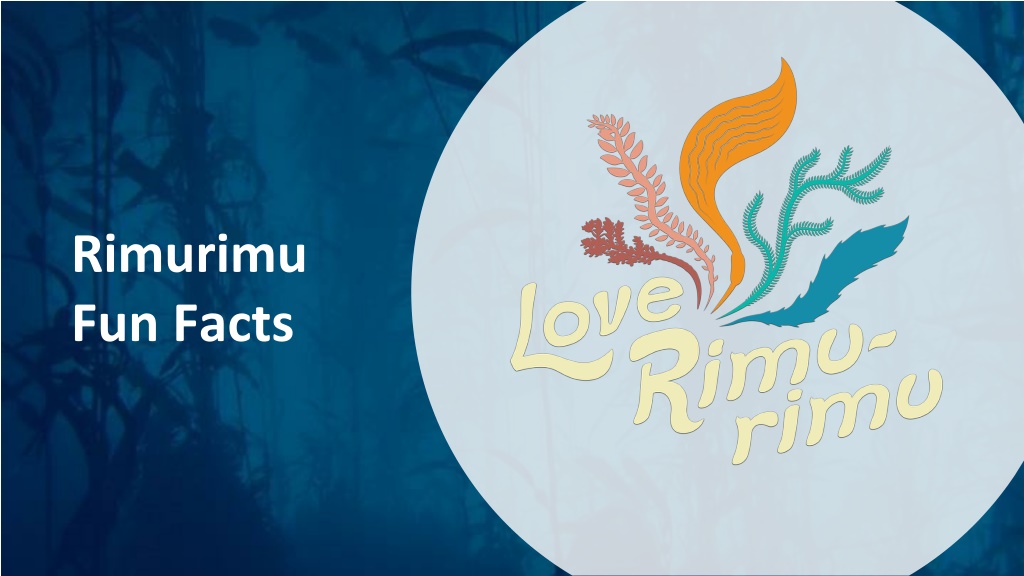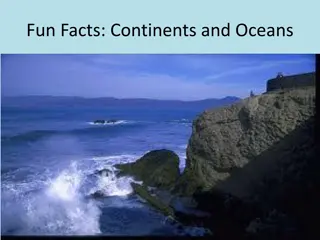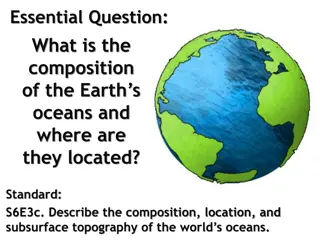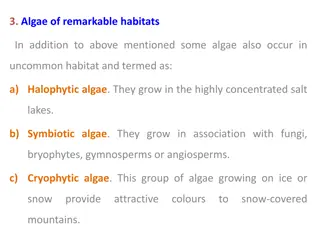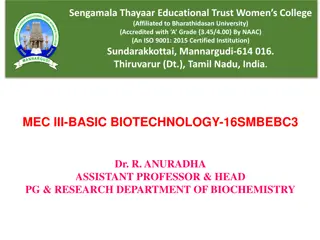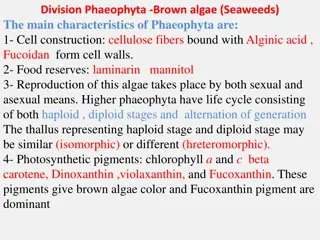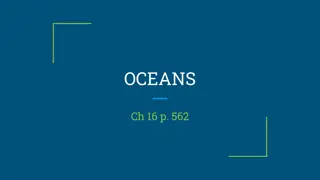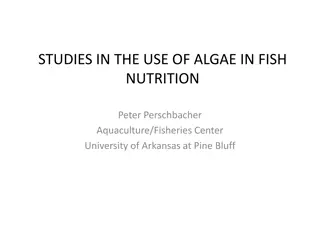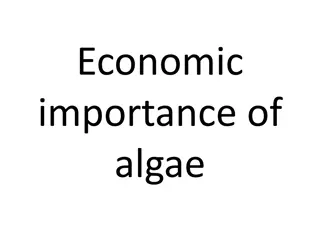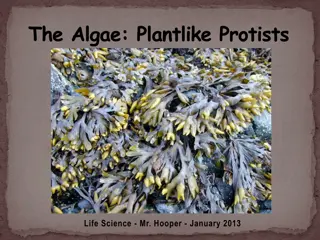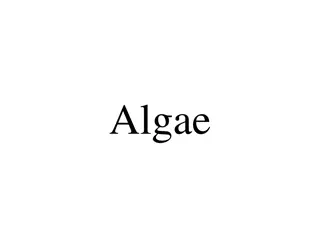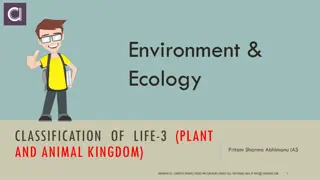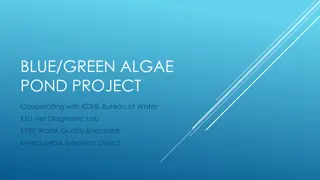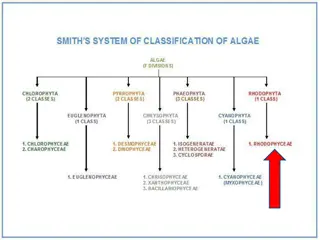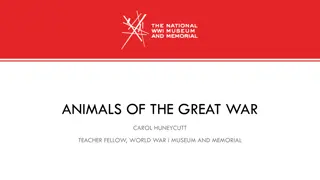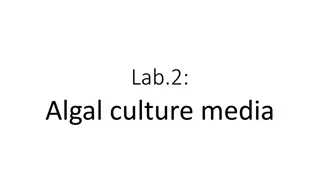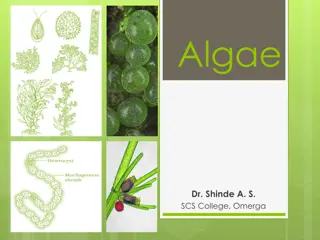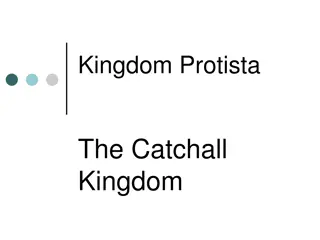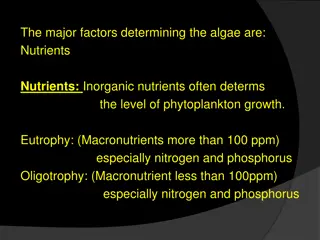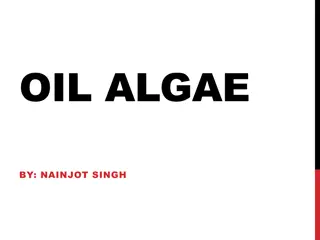Algae: Oceans' Unsung Heroes
Algae play a critical role in our planet's ecosystem, outnumbering plants on land. The oceans are teeming with microscopic algae and seaweeds, essential for marine life. Without algae, our oceans would be barren, highlighting their crucial ecological importance.
Download Presentation

Please find below an Image/Link to download the presentation.
The content on the website is provided AS IS for your information and personal use only. It may not be sold, licensed, or shared on other websites without obtaining consent from the author. Download presentation by click this link. If you encounter any issues during the download, it is possible that the publisher has removed the file from their server.
E N D
Presentation Transcript
Rimurimu Fun Facts
There is more algae than plants in the planet. It is estimated that there are 9 times more microscopic algae and seaweeds in the oceans than there are plants on land.
Without algae our oceans would be empty. Together, microscopic algae (phytoplankton) and macroscopic algae (seaweed) are responsible for all primary production in the ocean. They form the basis of the food chain harnessing energy from the sun.
Seaweeds are more efficient producers than our farm crops. Seaweed supports primary production levels that are 6 10 times greater than most intensive land-based agricultural systems.
Candidates to be the fastest growing organisms on the planet. For example, under optimal conditions, the giant kelp Macrocystis pyrifera, can grow nearly a metre a day growing up to 50m high.
Seaweed snacks will fuel you more than a steak. Seaweeds assimilate minerals directly from the sea and are thought to be the single most nutritious foods that you can eat. Rich in trace elements and vitamins, many of them frequently contain more protein than meat and more calcium than milk.
Veggie gardens will grow better with seaweed. Due to its high micronutrient contents, kelp is widely used as fertilisers and as plant growth stimulants.
Kelp is used as feed for farmed animals. Kelp is harvested as a feed and nutritional supplement for commercially farmed animals.
Ancient Greeks used it for healing purposes. Long before we were putting seaweed in our skincare lines, the Ancient Greeks were using it in their heated baths to draw out toxins from the body and rejuvenate their skin. This was known as Thalassotherapy (Thalasso is Greek for sea ) and the Greeks believed it could restore good health and cure illness.
It tastes like bacon! Are you thinking about going meatless? We ve got good news for you. Researchers at Oregon State University grew a strain of seaweed that tastes like bacon when it s fried. Not only does it taste delicious, but this patented strain of seaweed has twice the nutritional value of kale. The discovery, made in 2015, has opened doors in the vegan and vegetarian market. This seaweed bacon is not just vegan-friendly, but also gluten-free, low carbohydrate, organic, and sustainable. We now have a delicious and healthy alternative to bacon, all thanks to seaweed!
A third of dry seaweed is minerals. Seaweed has unique mineral content: by weight, about 34% of dried seaweed is comprised of minerals, making seaweed one of the best sources for these nutrients. They contain all of the minerals required by the human body, including both the macro minerals (calcium, magnesium, potassium, phosphorus, chloride, sulfur, and sodium) and trace minerals (including zinc, copper, and iron).
There are over 12,000 seaweed species.
A kelp forest the size of the Amazon rainforest would absorb more CO2 than humans produce. Having a seaweed forest covering 9% of the ocean would absorb more CO2than human activities produce.
Seaweed is not a plant! Seaweeds are not plants they are a type of algae. They have no roots, leaves or stems to transport water or nutrients. Instead each cell derives what it needs directly from the seawater around it. The only similarity between seaweed and land plants is that both rely on sunlight to create energy through photosynthesis.
Seaweed babies can swim! Some seaweeds reproduce by producing spores that actually have tiny flippers and swim away from the parent.
Seaweed elements can be found in many everyday items. Seaweed has elements that help turn liquids into gels, used in everything from ice cream to toothpaste.
New Zealands largest seaweeds are collectively called kelps and belong to the brown group.
The countrys largest kelp is Macrocystis pyrifera. Known as bladder kelp in New Zealand and giant kelp elsewhere. It can grow to 50 metres in length and 100 kilograms in mass.
Kina has a taste for a particular seaweed species. Common kelp (Ecklonia radiata) is the preferred food of kina (Evechinus chloroticus), which sometimes mass together and munch through an entire forest.
Seaweed can also become a pest. For example, Undaria is unwelcome in Aotearoa, it is an invasive species from Asia and a pest as it can change the structure and composition of native marine communities.
There are alien seaweed species in our ocean. Asian kelp (Undaria pinnatifida) arrived in New Zealand waters in the 1980s and quickly made itself at home in sheltered harbours.
Seaweed has been used for centuries in Aotearoa. M ori traditionally used a few species of red and green seaweed as food, and bull kelp or rimurapa, with its inflatable blades, for storage.
Karengo is the most commonly eaten seaweed. Also known as nori in Japan.
You can make seaweed bags. M ori made bags called p h by splitting open the blades and inflating them.
Karengo is a good winter snack. Karengo was an important supplement to the winter diet of M ori because of its high nutritional value up to 30% protein, and rich in vitamins and iodine.
Karengo fed soldiers in WWII. Dried karengo was sent to members of the M ori Battalion in the Middle East during the Second World War.
New Zealand exports a seaweed agar. New Zealand agar proved to be of very high quality and has been commercially produced since 1943. Today most of the seaweed is collected from south Wairarapa and then sent to p tiki where the agar is extracted.
Pua farmers feed them seaweed they collect. Marine farmers harvest approximately 300 tonnes of beach-cast and free-floating giant kelp every year in order to feed young p ua.
New Zealand has 850 native seaweeds, a third of which are endemic. TRUE.
Many marine animals are seaweedetarian. As the first organism in marine food chains, they provide nutrients and energy for animals either directly when fronds are eaten, or indirectly when decomposing parts break down into fine particles and are taken up by filter-feeding animals.
Red and green seaweed evolved earlier than brown seaweed.
Rimurimu whero grows deepest. The record is held by a calcareous red seaweed that was found at a depth of 268 meters, where only 0.0005% of the sunlight penetrates.
Some seaweeds make balloons. Some species have air-filled bladders, which ensure their access to light by holding them upright in the water.
Seaweed is mainly water. Depending on the species, fresh seaweeds are 70 90% water by weight.
Seaweed have life jackets. Some types of seaweed even have specialized bladders that allow it to float and colonise new areas.
Seaweed are the plants of the ocean. Like plants, seaweed depends on sunlight to create energy through photosynthesis and has simplified leaf and root structures that help anchor it in place.
There are different ways of creating a seaweed. Smaller types of seaweed use asexual reproduction, creating small spores that swim away from the parent, establish themselves in new locations, and grow into individual organisms. Other types create male and female cells that join and produce a new organism, similar to the way that moss reproduces.
Red algae has the most applications to human industry. Compounds like carrageenan or alginate have various applications in food and medical industries.
Kelp has many uses in human industry. Some of the larger kelps are also used to create fertilizers, medicines and dietary chemicals.
Rimurimu parone are the biggest of the seaweeds. Brown algae includes the kelp family and grows by far the largest out of the three varieties.
Seaweed has been part of human medicine for 2,000 years. Traditional Japanese and Chinese medicine were using seaweeds as ingredients for medicines and therapies as long as 2,300 years ago.
Having seaweed in your diet helps you live longer. A seaweed diet is linked to an increased life expectancy, Japanese Okinawa diet (low salt, high seaweed).
Too much seaweed, and your skin turns yellow! Excessive intake of dried seaweed has been reported to cause carotenodermia (yellowing of the skin).
Your toothpaste and shampoo have red seaweed in it! Red algae is harvested in large quantities to produce a vegetable gelatin used in a large number of foods and cosmetic products.
